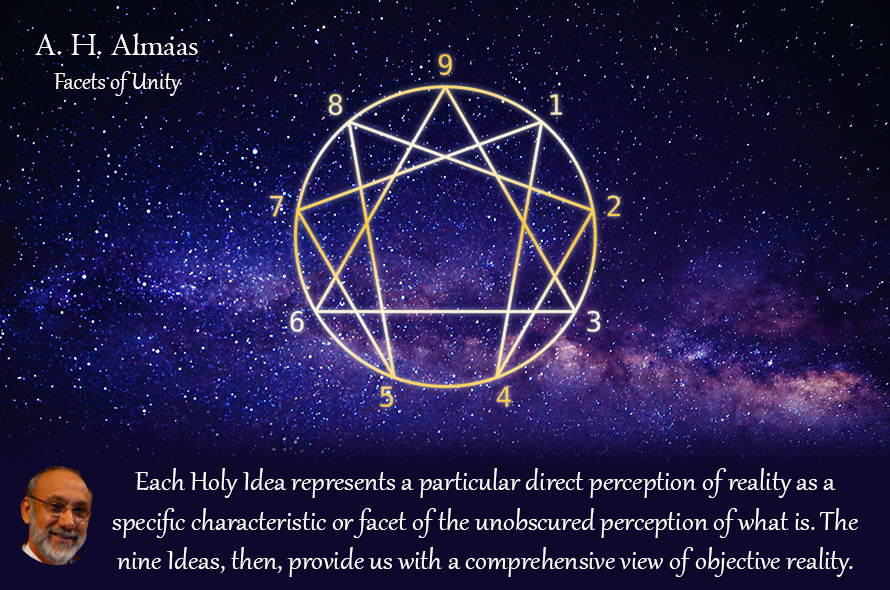Any perception of the infinite necessarily means several things in terms of spiritual awakening and development, says A. H. Almaas in this interview with Jessica Dibbs at the 2016 Enneagram Global Summit, the theme of which was “The Enneagram as an Entry into the Infinite.” For the enneagram to become a tool for accessing the infinite, it must go beyond the level of typology and psychological patterning, according to Almaas. That means touching into the spiritual dimensions of the Virtues and, in a larger context, the Holy Ideas. This recording is a copyright of The Shift Network. All rights reserved.
Click here to listen to the interview.
Infinite Views of the Infinite
The infinite is described in many ways by different wisdom traditions. Most people conceive of it in spatial and temporal terms, as something that is vastly expanding in time and space. This can be understood as corresponding to the idea of the boundless. But this is only one way of looking at it.
Gurdjieff talked about God as his “endlessness.” In the Kabbalah, Ein Sof means “endlessness” or “no end,” which suggests that there is no end to the ways true nature and reality manifest. Infinity can also mean the endless ways spiritual source can be experienced, or it might refer to the infinite nature of its qualities.
The most common way of experiencing the infinite is to feel you are infinite, that your spirit nature, your being, is unbounded. We can view this as the unity of all things, or non-duality. But no one tradition can claim to have found the “answer” to the infinite because the “infinite,” by definition, implies limitlessness to the ways it can be experienced. Quite literally, we cannot exhaust the possibilities of what infinity is, for the infinite is limitless potential.
The Infinite and the Enneagram
Several enneagram points offer pathways to experiencing the infinite through the Holy Ideas with which they are associated.
Point Nine
Point Nine is, perhaps, the most accessible. The Nine’s spiritual realization is Holy Love, which implies infinite goodness, or the inherent goodness of the infinite. If you feel goodness of spirit, you cannot help but feel love and see the whole of creation as an act of love. There is something fundamentally good that keeps life going. The more we realize this goodness, get a taste of it, the easier it is to open to the infinite.
At the core of each type is some childhood experience – what Almaas calls the “specific difficulty” – that makes it hard for us to experience that goodness. But even though we may be feeling shame, trauma, fear, insecurity and so on, the infinite goodness of reality is more powerful than these emotions. The more we feel it, the more we build commitment, confidence and faith to not lose heart in the midst of challenges.
Point Five
At Point Five we experience the infinite as boundlessness. When we know we are our true nature, we are infinite in our extension; there is no limit to our size or nature. The Holy Idea of the Five has two terms: Holy Omniscience, which describes “God’s mind”, and Holy Transparency, which means we are not separate from anyone or anything; we are transparent to everyone and everything.
The latter becomes the entry point to the infinite. If we work with our sense of separateness and are interested in it, we eventually see that our separateness is an idea and we are not bounded by our skin. That lack of separateness is the entry point to the infinite. There is no end to who, what or how we can experience because everything is one.
Point Three
At Point Three, we experience the infinite as Holy Hope. This has to do with generativity, or how things happen in the world. Things do not just “happen”; true nature is always generating reality, but each instant is a little bit different than the last, suggesting that this generation goes on endlessly; it is the sense that things unfold infinitely and will be fine. No singular thing can be everlasting. It will morph and move—even things we consider bad or difficult. There is curiosity, optimism and receptivity to the process of unfoldment.
Point Four
At Point Four, we experience the infinite as Holy Origin, which means that everything comes from the same source. Our source, or origin, takes us to the infinite depth of our nature. If we persist into that depth, we feel a sense of unobstructedness, which can lead to a feeling of emptiness. Within that emptiness, our experience of reality becomes infinite. The ways we can experience reality become an infinite wormhole that can take you anywhere.
The Four’s “specific difficulty” is the need to be special or unique. This is an issue of identity. But as we come closer to origin, we realize that it is what we are, and the sense of anything being special and/or unique disappears. This can eventually lead us to interpenetration, an understanding that everything is in us – everything that comes from that source – and also that all the qualities of the universe are within each quality.



